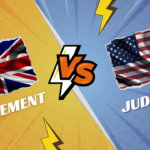English has lots of words with confusing spellings, like “labelled” and “labeled.” This article is here to help you understand the differences between these two spellings. We’ll look at where people use them, how they fit into sentences, and how they’ve changed over time. I’ll include examples and tables to make it easier to understand.
What is the Historical Background?
The difference between “labelled” and “labeled” can be traced back to the etymology of the word “label”. Originating from the Old French word “label” or “labeau”, it meant a strip or ribbon attached to a document. The spelling variations emerged with the division between American and British English.
British English:
- Historically favors doubling the consonant when adding a suffix if the last syllable is stressed and ends with a single vowel followed by a single consonant.
- Example: “travel” becomes “travelled”.
American English:
- Tends to simplify spellings and thus often does not double the consonant in similar scenarios.
- Example: “travel” becomes “traveled”.
| Region | Preferred Spelling | Example Sentence |
|---|---|---|
| American | Labeled | “The jar was labeled as ‘fragile’.” |
| British | Labelled | “She labelled the folders for easy access.” |
| Canadian | Labelled/Labeled | “He labeled/labelled the ingredients list.” |
| Australian | Labelled | “The package was labelled with care.” |
Grammatical Context and Usage
In American English:
- “Labeled” is the standard spelling.
- Used in all grammatical contexts: past tense, past participle, and as an adjective.
In British English:
- “Labelled” is the standard spelling.
- Follows the rule of doubling the final consonant when adding a suffix.
Here is a table for better understanding:
| Context | American English | British English |
|---|---|---|
| Past Tense | Labeled | Labelled |
| Past Participle | Labeled | Labelled |
| Adjective | Labeled | Labelled |
What is the main difference between “labelled” and “labeled”?
“Labeled” is preferred in American English, while “labelled” is the standard spelling in British English and other countries. The variation is rooted in historical and etymological factors, reflecting distinct language evolution paths.
Pro Tip: “Than” is for comparing, like ‘bigger than,’ and it has “than” right in it.
“Then” is for time or order, like ‘first, then next,’ with “e” and “n” just like “event” and “next.”
Examples for Better Understanding
Past Tense
- American: “She labeled the files yesterday.”
- British: “She labelled the files yesterday.”
Past Participle
- American: “All bottles have been labeled.”
- British: “All bottles have been labelled.”
As an Adjective
- American: “Look for the labeled boxes.”
- British: “Look for the labelled boxes.”
Conclusion
In conclusion, knowing the difference between “labelled” and “labeled” is mainly about understanding American and British English spelling. In America, it’s often “labeled,” while in Britain and some other places, it’s “labelled.”

